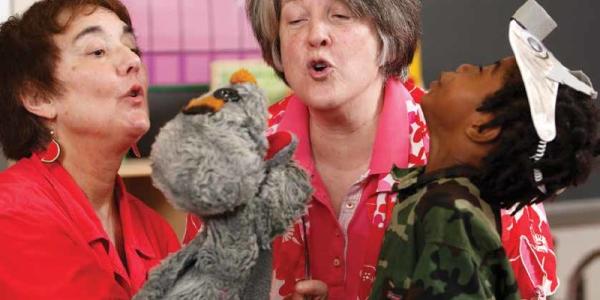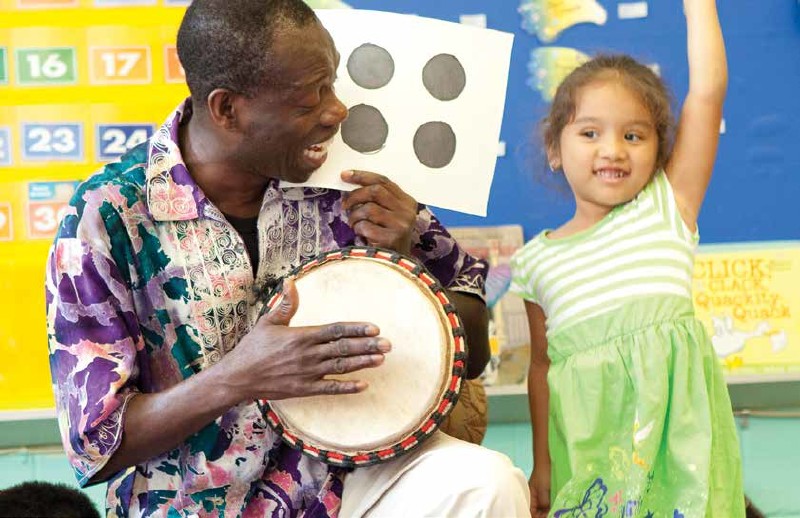Integrating Music, Drama, and Dance Helps Children Explore and Learn

You are here
"Oh no, the monkeys are loose! What can we do?”
It’s a simple question, but when a teacher, taking the role of a zookeeper, poses it to a group of children, learning happens. The scenario opens the door to creativity and free play. It introduces the concepts of animal needs and animal habitats. It sparks exploration of STEAM subjects (Science, Technology, Engineering, Arts, Mathematics), setting young children up for a lifetime as learners, problem solvers, and artists.
Integrating the arts
The teacher-in-the-role-of-a-zookeeper/monkeys-on-the-loose example represents one way teachers can integrate arts into curriculum to help young children explore and learn. Through the teacher-in-role approach, children learn by engaging in dramatic, active play. With this technique, the teacher brings the lesson to life and asks rich, open-ended questions that encourage children to apply critical thinking skills to activities that touch on all the STEAM fields.
Through decades of practice and research at the Wolf Trap Institute for Early Learning Through the Arts, we’ve seen that integrating the performance arts—music, drama, and dance—into core subjects helps young children learn better across the curriculum. Arts-integrated teaching taps into children’s natural desire for active learning through the senses. By singing, dancing, imagining, and connecting their bodies and minds, children learn more deeply and meaningfully, especially in subjects like reading, math, and science.
The Wolf Trap Institute developed a model using classroom residencies that paired professional teaching artists—musicians, dancers, actors, puppeteers—with early childhood educators to prepare teachers to lead with arts-integrated techniques. Working side by side with a teaching artist and receiving hands-on experience, teachers develop arts-based teaching skills. They discover how to promote innovative, high-quality learning by preschoolers through singing, dancing, role-playing, storytelling, and other performing arts activities. And it works.
A recent study confirmed that arts-integrated instruction techniques can boost learning in subjects other than the arts. Arts-integrated learning is not an extra or an add-on for early learning educators, but a valuable strategy to prepare young children for success in school.
Teacher-in-role
The teacher-in-role strategy challenges children to use creativity and critical thinking through dramatic play. Use this strategy to
- Help children solve a problem (where there is more than one way to solve it)
- Ask intentional, open-ended questions to guide children’s exploration
- Create a safe environment in which failure and revision are part of the process
In the zookeeper example, the teacher takes on a role and leads the children in a dramatic experience to help them practice problem solving. He guides them in using the six steps of the engineering design process:
- Define/identify the problem
- Plan the solution
- Build the solution
- Test the solution
- If it does not work, use what you learned to improve your plan and try again
- When it does work, share the results

Here is how the scenario might play out in a classroom:
Using the teacher-in-role technique, you can accept or encourage suggestions, even those that seem unlikely to work, and then help the children reflect on their practice to make revisions. Avoid giving the children the “correct” answer. Rather, let the children use the dramatic play experience to create, discover, and try again in a safe and engaging environment.
Creative experiences guided by intentional teaching produce learning opportunities for young children. Through drama, music, dance, and puppetry, children experience the joy of being artists while learning essential skills across the STEAM subjects. They approach challenges like engineers do. They learn fundamentals of mathematics when counting beats in a song. Through dance, they recognize patterns, which are an essential building block for algebraic thinking. Children tell stories in ways that prepare them to become readers and eloquent speakers. They become problem solvers as they apply important skills and strategies and build a foundation of STEAM tools to use in various situations.
When teachers effectively integrate the arts in lessons across the curriculum, children learn the fundamentals of math, language arts, and science that will prepare them for success in school, and for a life of engagement in the arts.
Building a Better Monkey Enclosure
identify the problem: the fence around the monkey enclosure is not high enough; the monkeys can climb on a rock and jump over the fence. With the help of the teacher/zookeeper, the engineers plan a solution to the problem: build a tall brick wall. (Even though the zookeeper thinks this may not be the best solution, he knows it is important to allow the discovery process to unfold.) The engineers use classroom blocks and other materials to build the wall.
After the children test the solution by talking about it more as a group, the brick wall grows higher, and the teacher-in-role of zookeeper announces another problem—because of the brick wall, the zoo visitors cannot see the animals! He asks, “Is there another material that will allow visitors to see the animals and the animals to see out?”
While the children consider a new strategy, the teacher/zookeeper presents yet another problem—the monkeys are sad and bored! When asked why, the children remember that monkeys love swinging from tree to tree. But if there are trees, how will the monkeys stay in the enclosure? And the problem-solving process continues.
To see more examples of creative STEAM experiences, or to learn about teaching artists residencies and arts-integrated learning, visit education.wolftrap.org, a free online community of practice that includes lesson plans, instructional videos, audio clips, and more.
Feature photo © Jonathan Timmes for Wolf Trap Foundation. Photo © Scott Suchman for Wolf Trap Foundation.
Jennifer Cooper is the director of the Wolf Trap Institute for Early Learning Through the Arts in Vienna, Virginia.